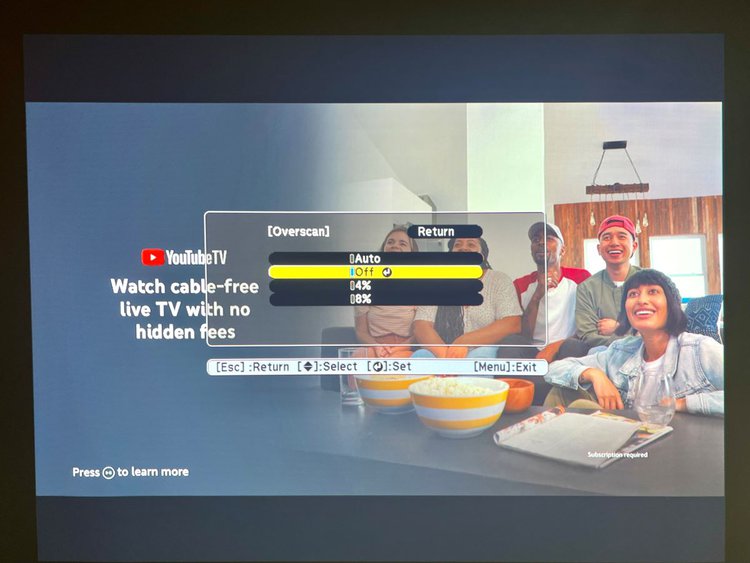What is Overscan on Projectors? A Closer Look at The Feature

What To Know
- Overscan is when the edges of a video signal are cropped or zoomed in, a phenomenon that can affect projectors, monitors, and TVs
- Overscan can slightly reduce picture sharpness, its effect is minimal if the projector’s resolution matches the content. If a discrepancy occurs
- Before adjusting overscan settings, it’s important to rule out other factors that could affect image cropping, such as projector positioning, aspect ratio settings, and dual display modes.
This guide delves into what overscan on projectors is, its effects on image quality, and how it compares to overscan on other devices like TVs and monitors.
Now, let’s find out.
Quick Navigation
What is Overscan?
If you see a portion of a particular scene playing on your TV, projector, or monitor being cut off, that’s overscan in action.
In technical terms, overscan is when the video input signal is beyond the display viewing area of a given device.
In layperson words, overscan is the zooming in or cropping of the image—although that’s a bit oversimplistic of a definition and also not fully correct.
The trimming usually happens at the edges.
Manually setting the picture to play in zoom mode is an aggressive version of overscan.
The picture is slightly smoothened when overscan happens, so the resulting pixelation isn’t very discernible.
Overscan was quite common in CRT (cathode-ray tube) televisions, which didn’t have a steady approach to positioning visuals within the screen’s borders. (Thank god we are well past them!)
Those CRT TVs were not adept at accurately reproducing pictures along the tube’s edges. Maybe the slightly rounded display had a role to play in it.
The TV, therefore, overscans the image to eliminate the irregularities by the sides, while not fiddling with the quality of the image’s center.
To prevent an overscan from biting too much into the integrity of a scene, show producers chose not to keep essential elements of a shot at the frame’s periphery.
As a result, it wouldn’t take much away from the visual’s core when overscan kicked in.
Generally, 5% of the area starting from the edges of a shot is devoid of a given scene’s essential elements.
“Safe title” or “title safe” is terminology denoting a region that’s reasonably away from the edges of the screen so that the text shows without distortion.
The opposite of an overscan is an underscan wherein a given picture is too small for a particular screen.
Overscan on Monitors and Projectors
Kindly note, overscan is not specific to CRT TVs. Modern televisions, computer monitors, projectors, and other devices, could have the issue too.
On an external monitor running Windows, for instance, an overscan could eat into the taskbar or the applications positioned to the far left on the desktop screen, as shown in the video below:
Overscan issues in a projector occur due to an input signal settings discrepancy. Generally, a projector is smart enough to automatically detect and optimize the signal settings.
But it could falter at times, and changing it is explained in simple steps below.
When Do I Need to Turn On or Off Overscan on My Projector?
Disable the feature if the overscan results in overtly softer and noisier visuals or impinges upon the scene’s vital aspects.
But an overscan is not always bad. The need to turn it on also arises at times.
Content creators still except TVs and projectors to crop images, which emboldens them to litter the edges of a shot.
The reverse is also true.
Device manufacturers anticipate content producers to leave the edges of a shot unattended, effecting an overscan as a result.
It’s like the chicken-egg conundrum.
In such cases, having overscan turned on helps unsee those visual irregularities.
Overscan’s Impact on Picture Sharpness

Although an overscan can make the images less sharp, the impact is minimal if the projector’s picture resolutions and content are identical.
And if the displayed content is a lot more pixel-dense, the cropping will have almost no effect on the image’s resolution.
For example, if the source content is 4K and the projector resolution is 1080p, the overscan should have no negative impact on the picture quality.
How to Turn on or Off Overscan on My Projector?
Turning on or off overscan is resizing the image you see on screen or viewing a particular scene in its entirety.
Generally, your projector takes care of it by itself. But when it doesn’t do it by default, head into its software settings to set it right. Here are the steps:
- Access your projector’s settings.
- From the sub-menus listed on the left pane, select Signal.
- Under Signal, select Advanced.
- Select the Overscan option and turn it on or off.
Kindly note that the above steps may vary based on the brand of projector you use.
In some cases, “overscan” could be mentioned as something else—for instance, “image ratio” or “dot for dot.”
That said, such varied terminologies are more common in televisions, thanks to TV manufacturers rebranding regular features and marketing those as their unique offerings.
Regardless, dig in and explore the options if they aren’t self-explanatory.
Rule Out Overscan Before Fiddling with the Setting
Before resorting to the above measures, confirm that the image-cropping concern is not due to an overscan. Here are things you could do to ensure that:
- Reset: As mentioned earlier, a projector usually doesn’t overscan images by default. If your device does, a system reset shall help set things right.
- Projector positioning: Make sure the projector is positioned correctly. In other words, ensure you’ve got the projector’s throw distance and angle right. You cannot use a short-throw projector as a long-throw device and expect the visuals to look complete after all.
- Aspect ratio: If the projector’s source is a laptop, see to it that the aspect ratios of the two devices are the same. The laptop’s aspect ratio must be set to match the width to height ratio of the projector screen.
- Dual display: In some cases, you may have set the computer to support two displays. Change the dual-display mode to normal if your device is trying to accommodate two screens.
Several set-top boxes, such as Amazon Fire TV, NVIDIA SHIELD, Apple TV, etc., have overscan settings as well.
Suppose you’ve hooked up an STB on your projector, which already has its overscan turned off.
If the cropping of images still persists with the projector, checking the overscan feature on the cable box and turning it off shall help.
Not to mention, the overscan option in the TV box may go by some other name.
How Much Overscan is Recommended?
There’s no right or correct level of overscan.
As mentioned earlier, cropping up to 5% of the original scene is pretty standard. 2.5% is usually the minimum amount of overscan done on an image.
Some high-definition televisions have an overscan of around 4 to 6%.
Conclusion
Quite clearly, the overscan issue isn’t as widespread as it once used to be, thanks to CRT TVs now being completely phased out.
Device manufacturers and content producers have been duly apprised of the changing technology.
Consequently, the majority are no longer creating provisions that they once did to accommodate the limitations of a cathode-ray.
That said, overscan is not entirely gone, and it can still pop up as a concern sporadically since some device makers and show producers anticipate the scenario and take measures to pre-empt that.
Luckily, projectors, televisions, computer monitors, etc., come with built-in options to turn overscan on or off when needed.
Hopefully, this article taught you how to enable or disable overscan on your projector and watch out for other image-related issues that could be hurting the projected visuals.
Catherine Tramell has been covering technology as a freelance writer for over a decade. She has been writing for Pointer Clicker for over a year, further expanding her expertise as a tech columnist. Catherine likes spending time with her family and friends and her pastimes are reading books and news articles.

